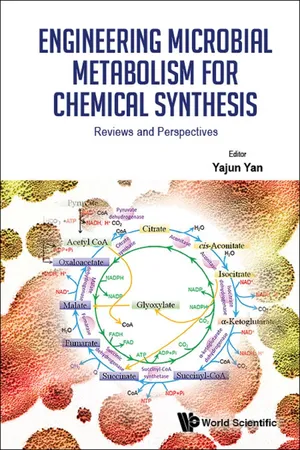
Engineering Microbial Metabolism for Chemical Synthesis
Reviews and Perspectives
- 272 pages
- English
- ePUB (mobile friendly)
- Available on iOS & Android
About This Book
-->
Microbial metabolism refers to how microbes obtain energy and nutrients needed to live and reproduce. Its uses in chemical synthesis are multiple, and, when engineered, can provide reliable and reproducible reactions for application in industrial or biogeochemical processes.
This book provides expert reviews and perspectives on how to engineer microbial metabolism for chemical synthesis. Major metabolic pathways or networks in microbial systems, including glycolysis, citric acid and photosynthesis, are briefly summarized. Following this, the metabolic engineering efforts of extending these pathways and networks for the biosynthesis of various chemicals are reviewed with the emphasis on the biochemical reactions and engineering strategies. The potential of these pathways for further metabolic engineering are also discussed. From graduate to professional level, cellular metabolism and metabolic engineering applications are introduced to the readers gradually and systematically, making it perfect for students, researchers and practitioners of chemistry, biochemistry and metabolic engineering.
-->
--> Contents:
- Glycolysis and Its Metabolic Engineering Applications (Jian Wang and Yajun Yan)
- Citric Acid Cycle and Its Metabolic Engineering Applications (Jia Wang and Xiaolin Shen)
- Amino Acid Biosynthesis and Its Metabolic Engineering Applications (Yi-Xin Huo)
- Fatty Acid Biosynthesis and Its Metabolic Engineering Applications (Yi Liu and Tiangang Liu)
- Photosynthesis and Its Metabolic Engineering Applications (Jason T Ku and Ethan I Lan)
- Pentose Phosphate Pathway and Its Metabolic Engineering Applications (Ying Wang and Chun Li)
- Mevalonate/2-Methylerythritol 4-Phosphate Pathways and Their Metabolic Engineering Applications (Xinxiao Sun and Qipeng Yuan)
- Xylose Metabolism and Its Metabolic Engineering Applications (Maria K McClintock and Kechun Zhang)
- Engineering Metabolism for the Synthesis of Polyhydroxyalkanoate Biopolymers (Guo-Qiang Chen and Xiao-Ran Jiang)
-->
--> Readership: Graduate students, researchers and practitioners of chemistry, biochemistry and metabolic engineering. -->
Keywords:Microbial Metabolism;Chemical Synthesis;Biosynthesis;Biochemical Reactions;Photosynthesis;Metabolic Engineering;Cellular Metabolism;GlycolysisReview:0
Frequently asked questions
Information
Chapter 1
Glycolysis and Its Metabolic Engineering Applications
1.1.Introduction
1.2.The Fundamentals of Glycolysis in Biological Systems
1.2.1.Glycolysis Pathway
 | (1.1) |
Precursor metabolite | Metabolic pathway |
Glucose-6-phosphate (G-6-P) | Glycolysis |
Fructose-6-phosphate (F-6-P) | Glycolysis |
Triose phosphate | Glycolysis |
3-Phosphoglycerate (3-PG) | Glycolysis |
Phosphoenolpyruvate (PEP) | Glycolysis |
Pyruvate | Glycolysis |
Ribose-5-phosphate (R-5-P) | PP pathway |
Erythrose-4-phosphate (E-4-P) | PP pathway |
Acetyl-CoA | TCA cycle |
α-Ketoglutarate (α-KG) | TCA cycle |
Oxaloacetate | TCA cycle |
Succinyl-CoA | TCA cycle |
Table of contents
- Cover
- Halftitle
- Title
- Copyright
- About the Editor
- Contents
- Chapter 1 Glycolysis and Its Metabolic Engineering Applications
- Chapter 2 Citric Acid Cycle and Its Metabolic Engineering Applications
- Chapter 3 Amino Acid Biosynthesis and Its Metabolic Engineering Applications
- Chapter 4 Fatty Acid Biosynthesis and Its Metabolic Engineering Applications
- Chapter 5 Photosynthesis and Its Metabolic Engineering Applications
- Chapter 6 Pentose Phosphate Pathway and Its Metabolic Engineering Applications
- Chapter 7 Mevalonate/2-Methylerythritol 4-Phosphate Pathways and Their Metabolic Engineering Applications
- Chapter 8 Xylose Metabolism and Its Metabolic Engineering Applications
- Chapter 9 Engineering Metabolism for the Synthesis of Polyhydroxyalkanoate Biopolymers
- Index